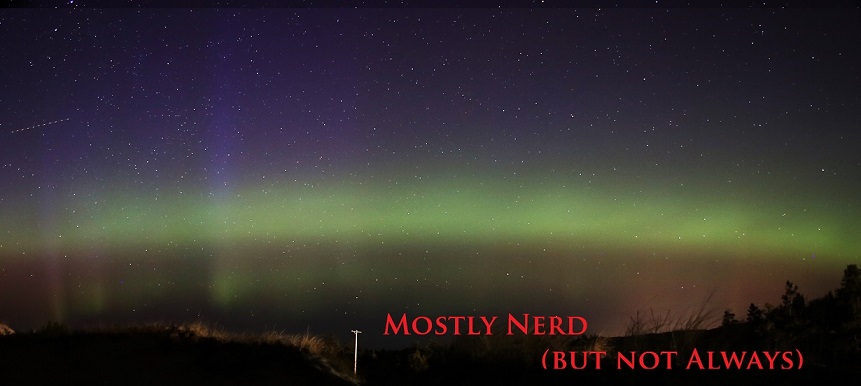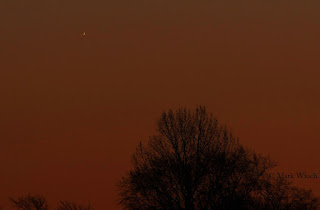In the enlarged image inset in this photograph I think that I can see the whole planetary disk not just the sunlit part.
Wednesday, March 22, 2017
Venus Update 3/22/2017
In the enlarged image inset in this photograph I think that I can see the whole planetary disk not just the sunlit part.
Tuesday, March 21, 2017
Evening Star in the Morning
As seen from our home planet, Venus never strays more than 45 degrees from the Sun. Because of this fact it either is referred to as the Evening Star when it sets after the Sun or Morning Star if it rises before the Sun. Today is one of the few days every eight years when it is both.
Since last summer Venus has been hanging out in the western sky at dusk. By Saturday it will pull even with Earth in the race around the Sun then become a prominent beacon in the dawn sky this spring and summer. As a result of the plane of its orbit being inclined with respect to Earth's orbit, Venus will not align with the Sun but rather pass nearly 9 degree north of it as seen from where we stand. That nine degree difference will for a few days allow the planet to precede the Sun in the morning while lingering in the western sky after sunset.
Today our sister planet rose at 7:17 AM (30 minutes before the Sun) and will set at 8:44 PM (44 minutes after the Sun). I was able (with the aid of binoculars) to find Venus just 9 minutes after it rose when its 1.6% illuminated crescent was just 1.3 degrees above the horizon. I took the following photo about 5 minutes later when it was 2.1 degrees high.
This evening I'll try to get a shot of it after sunset. Stay tuned. Update - got clouded out for evening observation attempt. Will try again tomorrow.
Here are a couple of not-to-scale diagrams illustrating how the planet can be observed both before sunrise and after sunset.
Since last summer Venus has been hanging out in the western sky at dusk. By Saturday it will pull even with Earth in the race around the Sun then become a prominent beacon in the dawn sky this spring and summer. As a result of the plane of its orbit being inclined with respect to Earth's orbit, Venus will not align with the Sun but rather pass nearly 9 degree north of it as seen from where we stand. That nine degree difference will for a few days allow the planet to precede the Sun in the morning while lingering in the western sky after sunset.
Today our sister planet rose at 7:17 AM (30 minutes before the Sun) and will set at 8:44 PM (44 minutes after the Sun). I was able (with the aid of binoculars) to find Venus just 9 minutes after it rose when its 1.6% illuminated crescent was just 1.3 degrees above the horizon. I took the following photo about 5 minutes later when it was 2.1 degrees high.
This evening I'll try to get a shot of it after sunset. Stay tuned. Update - got clouded out for evening observation attempt. Will try again tomorrow.
Here are a couple of not-to-scale diagrams illustrating how the planet can be observed both before sunrise and after sunset.
What ISS it? 3/4/2017
At first (through maybe ten) glance(s) the above photo appears to be an empty or extremely underexposed black field. It is neither.
Here is the technical data of the image....
Time/Date.........0643 AM/March 4, 2017.
Exposure..........1/1250 sec @ f/16 at ISO 2500
Focal Length ..700mm (500mm x 1.4x teleconverter)
Camera.............Canon 5d Mark IV
This version of the photo highlights the location of the subject.
No. A tighter crop shows the subject has an irregular shape to it.
A plane?
Nope, it's the International Space Station. The 356' wide object was 264 miles from my driveway when I took the handheld photo. I'm somewhat pleased with the result that I was able to obtain with my manually-focused lens at an effective 700mm focal length (500mm lens with a 1.4x teleconverter).
Things closer to my house than the ISS was when I took this photo....
Wrigley Field Chicago, IL.............153 miles
Ford Field Detroit, MI...................204 miles
Fort Wayne, IN..............................209 miles
Crane Creek SP, OH......................231 miles
Dubuque, IA..................................236 miles
Point Pelee NP Ontario.................243 miles
Copper Harbor, MI........................251 miles
Winona, MN..................................260 miles
Subscribe to:
Posts (Atom)










